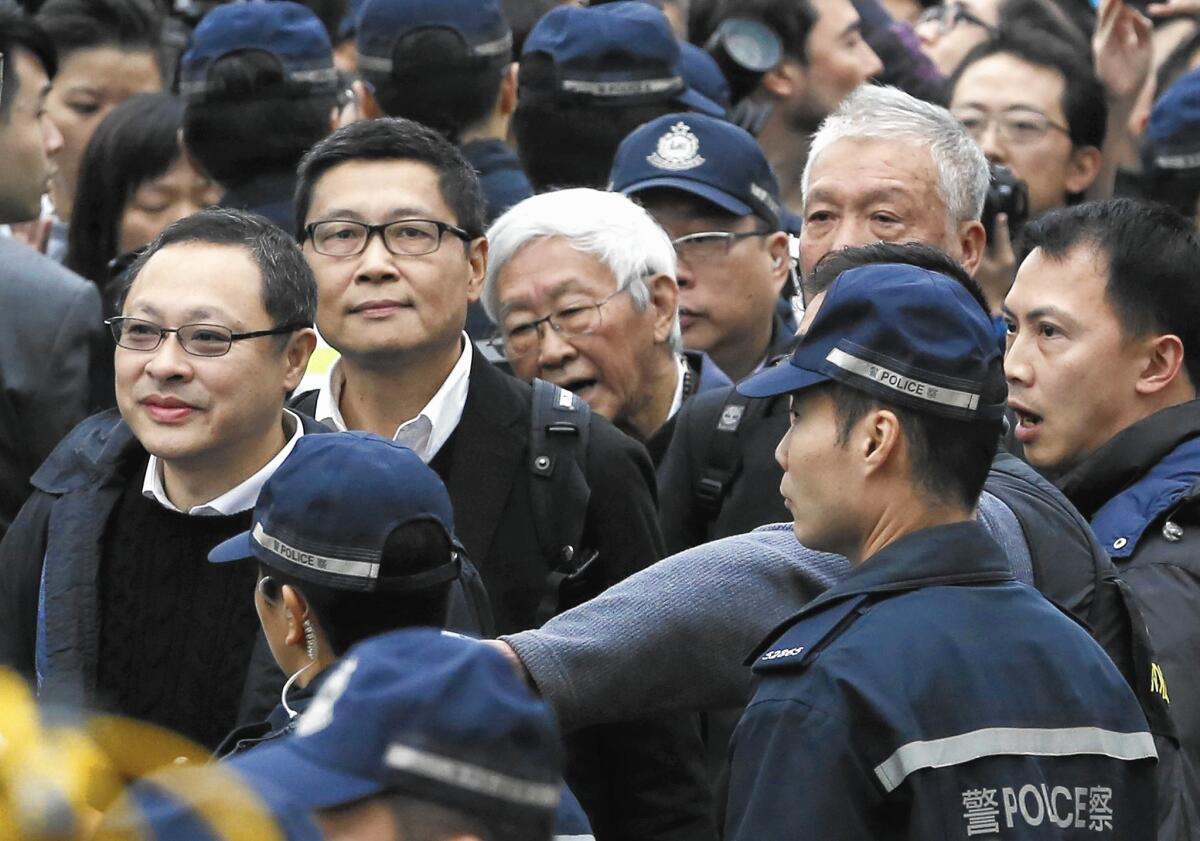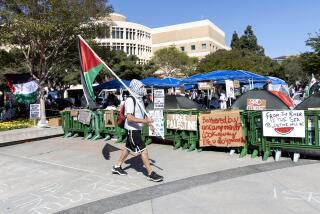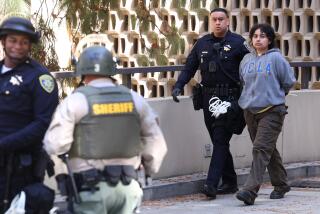Hong Kong protest movement pulls back — for now

Reporting from Hong Kong — When law professor Benny Tai first floated the idea for a Hong Kong democracy sit-in nearly two years ago, he suggested the friendly name Occupy Central With Love and Peace in the hope of inspiring more to follow his lead. For more than a year, the proposal garnered only tepid public support in this business-oriented, semiautonomous Chinese territory.
But one humid evening in late September, a few student demonstrators made a split-second decision to scramble up a barrier outside government headquarters. They were angered by an August decision by Beijing to essentially limit candidates in Hong Kong’s 2017 elections, and by the new metal fence before them — which they regarded as a physical embodiment of creeping government efforts to limit their right to protest.
Their move sparked a chain reaction far beyond Tai’s wildest dreams — and control. Energized by Hong Kong youths, and bolstered by a public shocked by a tough police response that included tear gas, Occupy Central was suddenly a reality, and it flowered into what became known as the Umbrella Movement, the longest pro-democracy street protest China has seen since Communists came to power in 1949.
The Umbrella Movement captured the attention of the world, but by the end of this week, it may be wiped from the streets, having extracted none of the concessions protesters so passionately — and politely, for the most part — sought from local authorities and their Communist overlords in Beijing.
A court has authorized a clearance operation Thursday, and opinion polls show the public’s patience for blocked roads has worn thin. Tai and other leaders have retreated, while some student organizers have gone on hunger strikes. Physical skirmishes between police and protesters — violent by Hong Kong’s decorous standards — have further eroded the movement of its once seemingly formidable power and moral high ground.
“The government has won this round. They have adopted a tricky and successful strategy — they have played this waiting game very nicely,” said Willy Lam, a political analyst and adjunct professor at the Chinese University of Hong Kong.
But while Hong Kong Chief Executive Leung Chun-ying and his patrons in Beijing may have prevailed in this battle, Lam and others warn that the war is probably far from over. The various social problems that have underpinned the protests — including a yawning wealth gap, sky-high housing costs and a flood of mainlanders swamping the small territory — are still festering.
“The students have achieved a seminal victory — they have built up this model of civil disobedience and mass mobilization in Hong Kong,” Lam said. “Civil society has matured. There is now a chance that these members of the ‘silent majority,’ who were never willing to come out before, can be mobilized to put pressure on government.”
As participants in the Umbrella Movement lick their wounds, plot their next steps and take stock of what went wrong, some say its greatest strengths — its diffuse leadership structure, its distance from established political figures, its utopian ethos — may also have been its biggest weaknesses.
“In a leaderless movement, it’s hard to make a strategic move because you don’t have the command of the whole crowd,” said Hong Kong legislator Fernando Cheung, an early supporter of Tai’s protest campaign, which targeted the financial district called Central. “There’s no mastermind. There certainly was no master plan.”
The Umbrella Movement had five pillars — Tai’s Occupy Central following, the Hong Kong Federation of Students college group, the high school activist organization Scholarism, local legislators like Cheung, and a coalition of civil rights groups.
But they rarely spoke forcefully with one voice. Different players emphasized different demands: Some called for Leung’s resignation; others insisted on the drafting of a new report to Beijing on the 2017 election rules; still others demanded the repeal of those rules.
Government authorities exploited the fractures. In mid-October, Leung’s administration agreed to hold a dialogue — but only with the Federation of Students. The talks failed to find any common ground, and an expected follow-up round never materialized.
All the while, government representatives in Hong Kong and Beijing kept emphasizing that the protests were illegal, economically disruptive and politically unrealistic.
But police generally hung back, and many members of the general public who initially feared a Tiananmen-style crackdown and came out to show solidarity with the students returned to their daily lives, their worries dissipated.
A cache of a few thousand true believers and holdouts, meanwhile, persisted in a utopian tent city of their dreams in the Admiralty district near government headquarters.
Many said they had no particular allegiance to any of the most visible leaders of the movement, even though Tai, Scholarism’s Joshua Wong and Federation of Students chief Alex Chow, among others, appeared regularly in the protest zone, giving speeches and attempting to keep up demonstrators’ morale.
By day, most of these high-school- and college-age demonstrators would go to class or work; others stayed behind to keep the site clean, orderly and well-stocked with donated staples and medical supplies.
By night, they would hold powwows to share their ideals and ideas for a better city, eschewing leadership by political figures and instead seeking decisions by consensus.
But a coherent strategy never really emerged, and demonstrators were slow to realize how quickly public support for their tactics was waning.
As warnings to clear the protest zones mounted, student leaders scrambled to launch a campaign to win back hearts and minds. Teams of high school and college students fanned out to neighborhoods, knocking on doors and trying to persuade people who were ambivalent or openly opposed.
“We overlooked other areas because we were too focused on the Occupy zones,” Federation of Students deputy leader Lester Shum acknowledged in mid-November. “There’s a lot more we can and should do besides occupying. We need to get those who support the end but not the means [of occupying]. So long as we believe in our fight, we should be able to communicate it to others.”
Business groups, meanwhile, were going to court, seeking injunctions that would allow them to clear the streets. And some protesters — fed up at the stalemate — started agitating for more aggressive methods.
A move by a small group of young men to bust through a wall of windows at government headquarters in late November only further hardened public opinion against the protests.
“In principle, there’s a strong argument we shouldn’t retreat because the movement hasn’t achieved any of its objectives,” said Cheung. “But it’s logical for us to retreat or to scale down the occupation.”
Though the movement appears to have hit a nadir, polls show continued public support for the protesters’ ultimate aims — open and fair nominations and elections of Hong Kong leaders. The challenge now is to find other means to press the campaign.
Michael Davis, a University of Hong Kong law professor, said protesters still had a multitude of tools available to them, such as boycotts, marches and flash-mobs.
“They’ve barely scratched the surface in terms of strategies to engender public support,” said Davis.
A broadening might already be happening: For more than two weeks after a site in the Mong Kok district was cleared by police with force, hundreds of demonstrators have been back on the streets night after night — strolling, evoking a scene reminiscent of mainland Chinese dissidents’ response to Tunisia’s 2011 Jasmine Revolution that forced that country’s president from office and led to democratic elections.
To carry on the fight, Tai and his Occupy Central cofounders have been emphasizing the need to construct a broad-based movement that includes academics, religious groups, legislators, students and others. Even though the student leaders have parted ways with the Occupy camp, they also agreed as much.
“In this movement there were a lot of self-organized people,” said Chow, the Federation of Students leader. “We need to have a more organized network going forward.”
On Tuesday, as the government foreshadowed its Thursday plans to sweep protesters off the streets, Chow sounded at once defiant and determined to carry on the fight in some way, shape or form.
“Clearance is tantamount to political suppression,” he said. “The government might think this is the political solution, yet the political time bomb will still be ticking.”
Special correspondent Law reported from Hong Kong and Times staff writer Makinen from Beijing.
More to Read
Sign up for Essential California
The most important California stories and recommendations in your inbox every morning.
You may occasionally receive promotional content from the Los Angeles Times.











